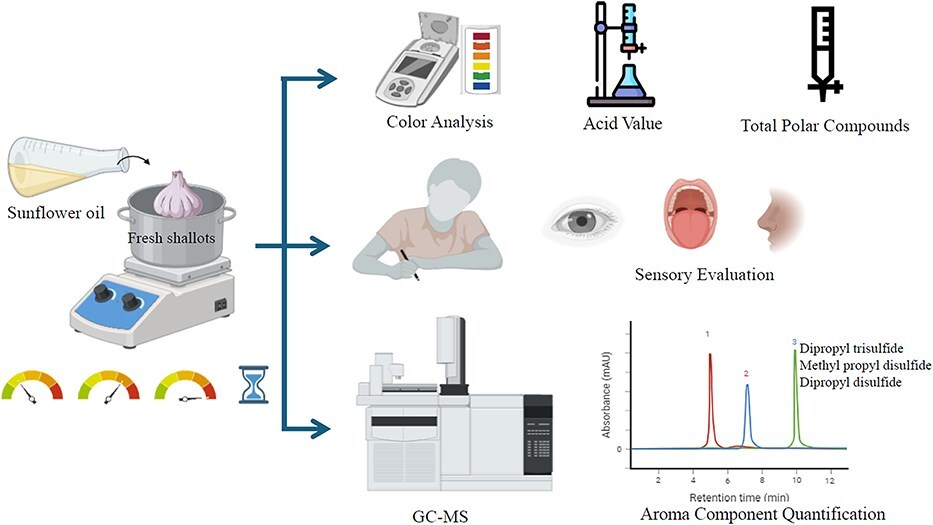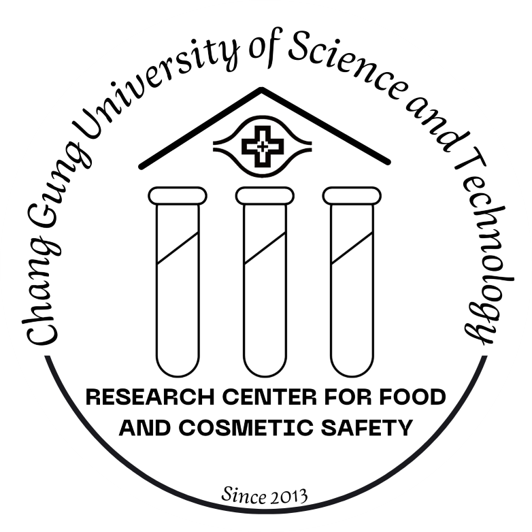Optimization parameters of shallot cooking oil making and sensory evaluation of organosulfur active components

圖文摘要說明
這張流程圖詳細展示了蔥油的製備過程,以及用於優化其感官品質和建立標準化生產方法的各項分析與評估。
圖片左側是蔥油的製備過程:
- 一個攪拌器上放置著一個裝有新鮮紅蔥頭 (Fresh shallots) 和葵花籽油 (Sunflower oil) 的鍋子,鍋中冒著蒸汽,表示正在加熱。
- 鍋子下方有三個從紅到綠的圓形儀表,以及一個沙漏圖標,代表不同的加熱溫度、時間和攪拌速度,這些是製備過程中的變量。
從這個製備過程引出三條箭頭,指向右側的各種分析和評估方法:
1. 第一條箭頭(上方): 指向理化性質分析。
- 顏色分析 (Color Analysis): 一個手持色度計,旁邊顯示色板,用於測量蔥油的顏色變化。
- 酸價 (Acid Value): 一個滴定裝置,用於測量油品的酸價,反映其水解酸敗程度。
- 總極性化合物 (Total Polar Compounds): 一個實驗裝置,用於測量油品中熱氧化產物,反映氧化變質程度。
這三項分析共同評估蔥油的理化品質。
2. 第二條箭頭(中間): 指向感官評估 (Sensory Evaluation)。
- 一個坐著的人正在書寫,代表進行感官評估的評審員。
- 三個頭部特徵圖標:眼睛(視覺)、嘴巴(味覺)和鼻子(嗅覺),表示評估涵蓋了油品的顏色、風味和氣味等多方面感官屬性。
3. 第三條箭頭(下方): 指向香氣成分分析 (Aroma Component Quantification)。
- 一個 GC-MS (氣相層析串聯質譜儀) 儀器,用於分離和鑑定蔥油中的揮發性香氣化合物。
- 旁邊是一個 層析圖,顯示兩個清晰分離的峰(標記為 1 和 2),並在右側列出其對應的香氣化合物:二丙基三硫醚 (Dipropyl trisulfide)、甲基丙基二硫醚 (Methyl propyl disulfide) 和二丙基二硫醚 (Dipropyl disulfide),這些是主要的有機硫化合物。這部分用於定量分析蔥油的香氣成分。
總結來說,這張圖完整呈現了從蔥油製備條件的變更,到運用多種科學方法(理化分析、感官評估、GC-MS)來全面評估和優化蔥油品質的研究流程。
Abstract
Shallots, widely used in Chinese and Western cuisines, are rich in vitamin C, dietary fiber, antioxidants, and organosulfur compounds like quercetin and allicin, which offer antibacterial, antiallergic, and hypoglycemic benefits. This study aims to optimize the heating process for shallot oil to enhance its sensory quality and establish standardized production methods. Shallot oil samples were prepared under varying temperatures and times, and their aroma profiles were analyzed using gas chromatography-tandem mass spectrometry (GC-MS). Sensory evaluations identified 120-150°C for 3 minutes as the optimal heating condition, yielding the most consumer-acceptable flavor profile. Essential aroma compounds, including dipropyl trisulfide and methyl propyl disulfide, showed reduced content under these conditions, balancing aroma retention and sensory appeal. Storage tests demonstrated that shallot oil processed at optimal conditions retained its quality for up to one year. These findings provide insights for developing high-quality shallot oil products, though further research is warranted.
Keywords:cooking oil, gas chromatography–mass spectrometry, sensory evaluation, shallot

